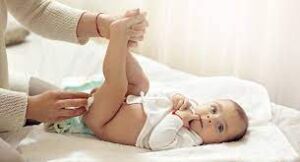Choosing the Right Baby Diaper: A Guide for Parents
Nappy changing is an important part of caring for a baby. It is a necessary task that requires careful preparation and attention to detail. It is important to ensure that all necessary supplies are available, and that a safe and comfortable environment is provided for the baby. It is also important to know the correct techniques for changing a nappy, such as properly cleaning the baby’s bottom and properly disposing of the used nappy. With proper preparation and attention to detail, nappy changing can be a quick and easy task. Please keep reading for details on the following topics:
How to determine that a baby’s diaper needs changing
How to change a diaper
Common Challenges and Solutions

HOW TO DETERMINE WHEN A DIAPER NEEDS CHANGING
- Wetness Indicator Line: Many modern diapers come with a wetness indicator line, usually a blue line, that changes color when the diaper is wet. If this line appears, it indicates that the diaper is likely wet and needs changing.
- Dampness: You can check if the diaper feels damp by gently touching the outside of it. A damp diaper is a clear sign that it needs changing.
- Visible or Smell of Stool or Urine: If you can see or smell stool or urine in the diaper, it’s a definite indication that it needs changing.
- Bulky Appearance: A diaper may look or feel bulky when it’s saturated with urine. If you notice this, it’s a sign that the diaper needs changing to maintain the baby’s comfort and hygiene.
HOW TO CHANGE A BABY’S DIAPER
Here’s a step-by-step guide on how to change a baby’s diaper:
- Gather Supplies: Before starting, have everything within reach to avoid leaving the baby unattended:
- Clean diaper (disposable or cloth).
- Baby wipes or a soft cloth with warm water.
- Diaper rash cream or ointment (optional, for preventing diaper rash).
- Changing pad or a flat clean surface.
- Disposable bag or diaper pail for soiled diapers.
- Prepare the Changing Area: Lay the baby on their back on a flat surface, such as a changing table or diaper changing pad, ensuring it’s safe and comfortable.
- Remove Soiled Diaper: Open the tabs or fasteners of the dirty diaper and carefully lift the baby’s bottom, then slide the diaper out from underneath. Dispose of the soiled diaper properly in a trash can.
- Clean Baby’s Bottom: Use wipes or a wet washcloth to gently clean the baby’s genital area. For girls: Wipe from front to back to prevent infections. For boys: Ensure to clean around and under the scrotum. Cover the penis with a clean cloth during changing to avoid accidental spraying. If necessary, clean around the umbilical cord stump with water or as per your pediatrician’s recommendation.
- Dry Baby’s Bottom: Pat the baby’s bottom dry with a clean cloth or let it air dry for a moment to prevent irritation.
- Apply Diaper Cream (If needed): If the baby has a diaper rash or irritation, apply a thin layer of diaper rash cream to protect their skin.
- Prepare the New Diaper: Place a clean diaper beneath the baby, with the back side under their bottom and the front side between their legs. Ensure the tabs or fasteners are at the back.
- Secure the Diaper: Bring the front of the diaper up between the baby’s legs and attach the tabs or fasteners snugly but not too tight. For boys, ensure the penis is pointing downward to prevent leaks.
- Check for Fit: Slide a finger between the diaper and the baby’s tummy to ensure it’s not too tight. The diaper should fit comfortably but snugly.
- Fold the dirty diaper, fasten it with the tabs, and place it in a disposable bag or diaper pail.
- Wash your hands thoroughly with soap and water.
Common Challenges and Solutions
1. Baby Won’t Stay Still
Solution: Keep a small toy or rattle nearby to distract them during changes.
2. Diaper Rash
Solution: Ensure the area is cleaned and dried thoroughly. Use diaper rash cream as needed and consider switching diaper brands if the rash persists.
3. Leaks
Solution: Check the size and fit of the diaper. Ensure it is fastened snugly and not too loose.
Disclaimer: The information provided in this content is for general informational purposes only. It is not intended as medical or healthcare advice, diagnosis, or treatment. Always seek the advice of a qualified healthcare professional with any questions you may have regarding a medical condition or healthcare decisions.

